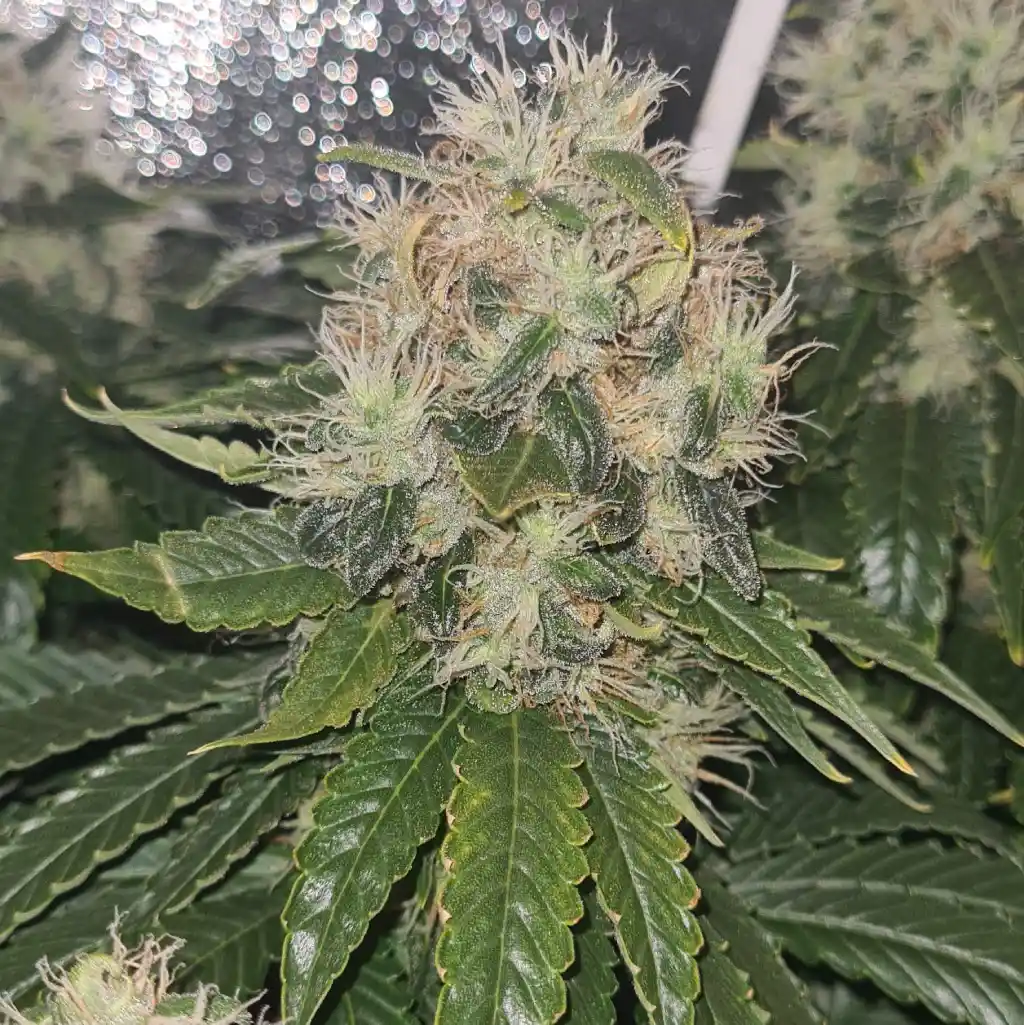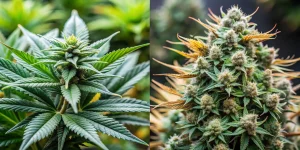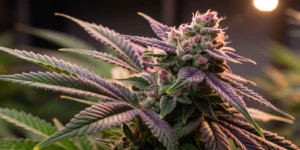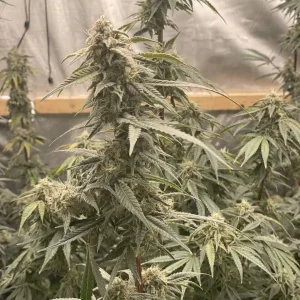Dark Phoenix: Exceptional Genetics and Effects
Dark Phoenix is a highly sought-after cannabis strain, renowned for its exceptional genetics and unique effects. This hybrid is the result of crossing Jack Herer and Trainwreck, two legendary strains celebrated for their potent and uplifting characteristics. Dark Phoenix boasts a balanced blend of indica and sativa traits, making it versatile for both recreational and medicinal use.
With THC levels often exceeding 20%, this strain delivers a euphoric cerebral high complemented by a soothing body relaxation. Its flavor profile combines earthy pine with citrus undertones, creating a refreshing and memorable experience for users. Whether you’re a seasoned grower or a novice, cultivating Dark Phoenix strain can be a rewarding endeavor.
Environmental Requirements for Growing Dark Phoenix Strain
Dark Phoenix thrives in environments that mimic Mediterranean climates. Optimal temperatures for this strain range between 70°F and 85°F, with moderate humidity levels. Proper ventilation and consistent airflow are crucial for preventing mold and mildew, especially during the flowering stage.
This strain performs well both indoors and outdoors. For indoor setups, maintaining a controlled environment with proper light cycles (18/6 during vegetative and 12/12 for flowering) ensures healthy growth. Outdoors, Dark Phoenix flourishes in sunny, sheltered locations where it can receive ample sunlight.
Setting Up the Growing Cannabis Space
Indoor Cannabis Cultivation
When cultivating Dark Phoenix indoors, a grow tent or dedicated grow room equipped with high-quality LED or HID lights is ideal. These lights should provide full-spectrum coverage to support all growth stages. Keep humidity levels between 50-70% during the vegetative phase and lower them to 40-50% during flowering to prevent bud rot.
Use well-aerated soil or a hydroponic system for faster nutrient absorption. Installing oscillating fans and carbon filters helps maintain air circulation and control odors, ensuring a healthy and discreet growing environment.
Outdoor Cannabis Cultivation
Dark Phoenix thrives outdoors in climates with long sunny days and mild evenings. Planting after the last frost ensures stable temperatures for optimal growth. Choose well-draining soil enriched with organic compost to provide the necessary nutrients.
To protect plants from pests and harsh weather, use companion planting or natural barriers. Staking or trellising can support the plant’s structure as it grows, especially during the flowering stage when buds become dense and heavy.
Propagation and Germination of Dark Phoenix Strain
Successful cultivation starts with high-quality seeds from a trusted source. To germinate, use the paper towel method: place seeds between damp paper towels and keep them in a warm, dark location. Within 24-72 hours, taproots should emerge, indicating they are ready for planting.
Transfer germinated seeds to small pots with nutrient-rich seedling soil. Keep the soil moist but not waterlogged and provide gentle lighting to encourage healthy growth. Once seedlings develop a few sets of leaves, they can be transplanted into larger containers or outdoor beds.
Vegetative Phase of Dark Phoenix Strain
During the vegetative phase, Dark Phoenix displays vigorous growth, developing strong stems and lush foliage. This phase typically lasts 4-8 weeks, depending on growing conditions and desired plant size. Provide ample nitrogen-rich nutrients to support this rapid development.
Maintain a light cycle of 18 hours on and 6 hours off for indoor grows. Regularly prune lower leaves and train plants using techniques like topping or low-stress training (LST) to promote even canopy growth and maximize light exposure.
Flowering Phase of Dark Phoenix Strain
The flowering phase begins when plants are exposed to a 12/12 light cycle or as days naturally shorten outdoors. This stage lasts approximately 8-10 weeks, during which Dark Phoenix develops dense, resin-coated buds with a captivating aroma.
Switch to bloom-specific nutrients high in phosphorus and potassium to support bud production. Monitor plants closely for signs of pests or mold, as dense buds can be susceptible to infestations. Trichomes will turn milky white with amber hints when the strain is ready for harvest.
Cannabis Fertilization and Nutrition – Dark Phoenix Strain
Dark Phoenix requires a tailored nutrient regimen to achieve optimal yields. During the vegetative stage, focus on nitrogen-heavy fertilizers to support leaf and stem growth. As the plant transitions to flowering, switch to phosphorus and potassium-rich nutrients to enhance bud development.
Incorporating organic amendments like bat guano or kelp meal can improve soil quality and boost microbial activity. Regularly flush the growing medium with plain water during the final two weeks to remove excess salts and improve flavor.
Pest and Disease Control for Cannabis Growing
Prevention
Maintaining a clean grow space is essential for preventing pests and diseases. Use neem oil or insecticidal soap as a preventative measure and introduce beneficial insects like ladybugs to control aphids and mites. Adequate air circulation and proper humidity levels further reduce the risk of mold and mildew.
Corrective Actions
If infestations occur, isolate affected plants and treat them promptly with organic or chemical solutions. For fungal issues, prune infected areas and apply fungicides. Monitoring plants regularly ensures early detection and effective management of problems.
Harvesting and Curing for Cannabis Growing
Dark Phoenix is typically ready for harvest 8-10 weeks after flowering begins. Look for buds with milky white trichomes and a few amber tips to determine peak potency. Use sterilized scissors to cut branches and hang them upside down in a dark, well-ventilated space.
Once dried, cure the buds in airtight jars, opening them daily for the first week to release moisture. This process enhances the flavor, aroma, and potency of the final product, ensuring a premium cannabis experience.
Is Dark Phoenix Strain Indica or Sativa?
Dark Phoenix is a balanced hybrid, combining the best traits of both indica and sativa strains. Its effects start with an uplifting cerebral high, followed by a calming body relaxation, making it suitable for various occasions.
Advantages of Growing Dark Phoenix Strain
- High Yields: Dense buds produce impressive yields, especially under optimal conditions.
- Resilience: Strong genetics make this strain resistant to common pests and diseases.
- Versatile Effects: Suitable for both recreational and medicinal use, catering to a broad audience.
Disadvantages of Growing Dark Phoenix Strain
- Moderate Maintenance: Requires consistent monitoring and care to achieve maximum potential.
- Humidity Sensitivity: Dense buds can be prone to mold in high-humidity environments.
- Space Requirements: Can grow tall, needing ample vertical space or training techniques.
Problems in Cultivating Dark Phoenix Strain
Common issues include overwatering, nutrient imbalances, and pest infestations. Regularly check soil moisture levels and adjust feeding schedules to avoid nutrient burn or deficiencies. Proactive pest management ensures a healthy growing cycle.
Advanced Pest Control for Cannabis Growing
For persistent pest problems, consider integrated pest management (IPM) strategies. Use biological controls, such as predator insects, alongside organic treatments. Maintaining a balanced environment minimizes the risk of recurring issues.
Similar Strains
For growers and consumers who enjoy the unique characteristics of Dark Phoenix, several other strains offer comparable experiences and cultivation benefits. These strains are perfect for those looking to explore similar profiles in aroma, flavor, and effects.
Trainwreck
Trainwreck is a sativa-dominant hybrid known for its cerebral high and energizing effects. With earthy and pine aromas, Trainwreck thrives in similar environments to Dark Phoenix, making it a versatile choice for growers in temperate climates. This strain offers a shorter flowering time and is resistant to many common pests, ideal for outdoor cultivation.
Trainwreck’s stimulating properties make it popular among creative individuals. Its high THC content pairs well with its uplifting effects, providing a balanced yet potent experience for seasoned users.
Super Silver Haze
Super Silver Haze is another sativa-dominant strain with a reputation for vibrant citrus flavors and uplifting effects. It thrives in warm, humid climates and responds well to hydroponic systems in indoor settings. Like Dark Phoenix, it offers high yields and dense, resinous buds.
This strain is ideal for users seeking an energetic boost or daytime relief from stress and fatigue. Its terpene profile includes limonene and myrcene, which contribute to its refreshing aroma and therapeutic benefits.
Granddaddy Purple
Granddaddy Purple (GDP) is an indica-dominant strain celebrated for its deep relaxation and fruity grape flavor. While it contrasts with the uplifting nature of Dark Phoenix, GDP’s robust growth and resistance to environmental stressors make it a complementary option for growers seeking variety.
This strain excels in both indoor and outdoor environments and has a relatively short flowering time. Its calming effects and striking purple hues make it a favorite among medicinal users and recreational consumers alike.
Week-by-Week Growth Plan for Dark Phoenix Strain
Achieving optimal results with Dark Phoenix requires a structured growth plan tailored to its unique needs. Here’s a week-by-week guide to help growers maximize yields and potency.
Weeks 1-2: Germination and Seedling Stage
- Light: Provide 18-20 hours of light daily using full-spectrum LED lights.
- Environment: Maintain temperatures between 70°F and 75°F with 65-70% humidity.
- Care: Use a seedling mix or light soil with minimal nutrients. Keep the soil moist but avoid overwatering.
The seedlings should sprout within 3-7 days. Ensure proper air circulation to prevent mold and pests.
Weeks 3-4: Vegetative Stage
- Light: Continue with 18-20 hours of light per day.
- Nutrients: Introduce nitrogen-rich fertilizers to encourage leafy growth.
- Environment: Maintain temperatures between 72°F and 80°F with 50-60% humidity.
Train the plants using low-stress techniques to promote even canopy growth and maximize light exposure.
Weeks 5-6: Early Flowering Stage
- Light: Switch to a 12/12 light schedule to initiate flowering.
- Nutrients: Transition to bloom-specific fertilizers with higher phosphorus and potassium content.
- Environment: Lower humidity to 40-50% to prevent mold on forming buds.
Monitor for early signs of flowering and adjust the feeding schedule accordingly.
Weeks 7-9: Full Flowering Stage
- Light: Maintain the 12/12 schedule.
- Care: Focus on consistent watering and nutrient application to enhance bud development.
- Environment: Keep temperatures steady between 68°F and 75°F with 40% humidity.
Check trichomes regularly; milky white trichomes signal that harvest time is approaching.
Weeks 10-11: Harvest and Post-Harvest
- Harvest: Cut the plants when trichomes are mostly cloudy with a few amber hues.
- Drying: Hang the branches in a dark, ventilated room with 50% humidity and temperatures around 70°F.
- Curing: Place dried buds in airtight jars, opening them daily during the first week to release moisture.
Curing enhances the flavor, aroma, and potency of Dark Phoenix, resulting in a superior final product.
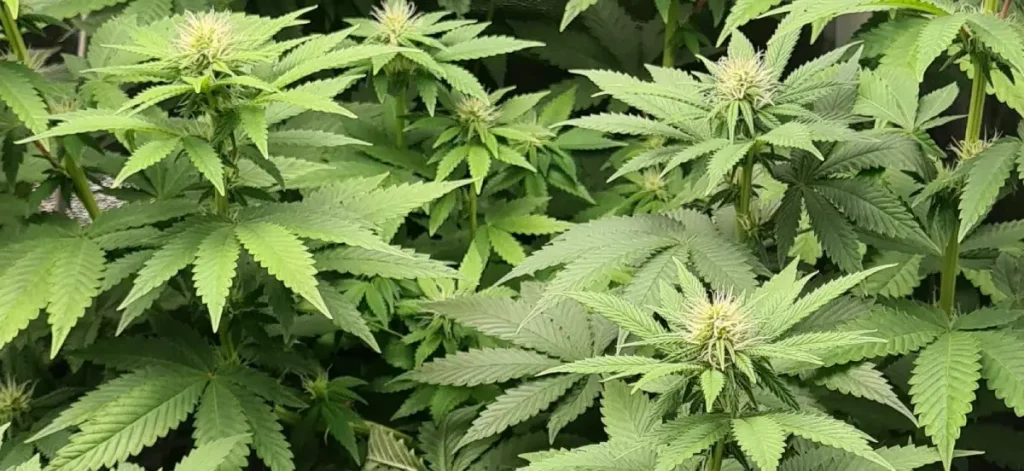
FAQs About Dark Phoenix Strain
What are the ideal growing conditions for Dark Phoenix?
Dark Phoenix thrives in warm, sunny climates with consistent temperatures between 70°F and 80°F. It prefers a controlled indoor environment with full-spectrum lighting or outdoor settings with ample sunlight. Maintaining humidity levels at 40-50% during flowering is crucial to prevent mold and mildew.
Growers should provide a nutrient-rich soil or hydroponic setup and use fertilizers tailored to each growth stage. Regular monitoring and care ensure robust growth and high yields.
How long does it take to grow Dark Phoenix?
Dark Phoenix has a total growth cycle of approximately 10-11 weeks. The vegetative stage typically lasts 3-4 weeks, followed by a flowering period of 7-8 weeks. Harvest times may vary based on environmental conditions and cultivation methods.
To achieve optimal potency and flavor, growers should monitor trichome development closely and adhere to proper drying and curing techniques after harvest.
What makes Dark Phoenix unique compared to other strains?
Dark Phoenix stands out for its balanced sativa-indica effects, delivering both cerebral stimulation and physical relaxation. Its rich terpene profile combines earthy, citrus, and pine notes, creating a multi-dimensional flavor experience.
The strain’s robust genetics make it resistant to common pests and diseases, appealing to novice and experienced growers alike. Additionally, its high THC content and versatility make it a favorite among recreational and medicinal users.

